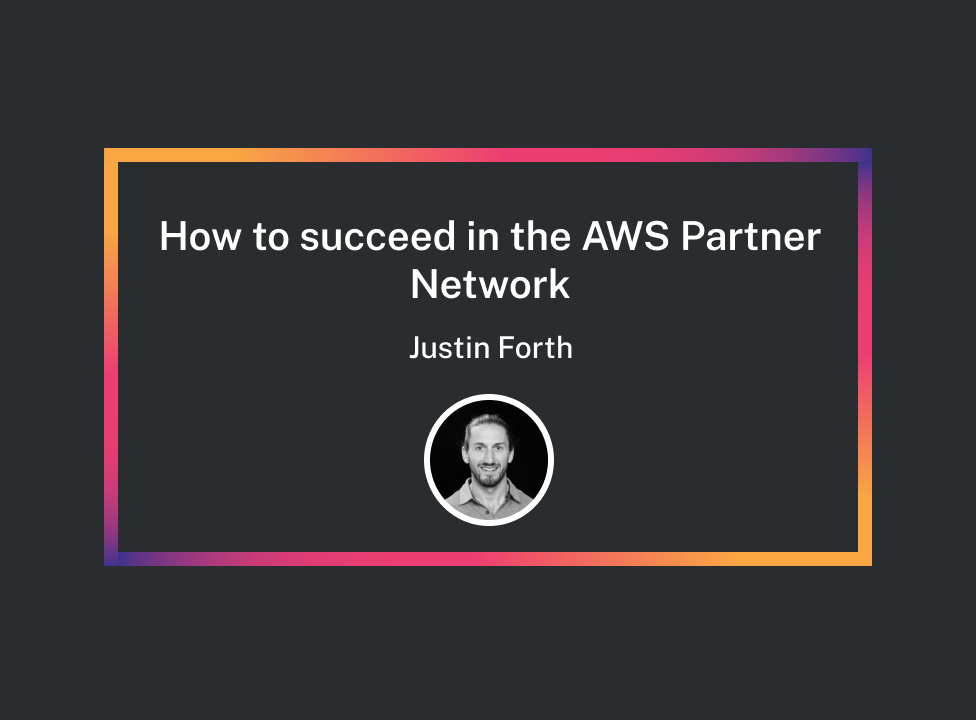Justin Forth is the Director of Strategic Partnerships at LogicMonitor. He worked for 3 years at AWS helping startups navigate and thrive in the AWS Partner Network. In this article, Justin explains not only why it is important to partner with AWS but also the 5 essentials that you need to succeed in the AWS Partner Network.

Why you should join the AWS Partner Network
AWS got an early lead in the cloud computing market, as it took several years for Google or Microsoft to build remotely competitive cloud ecosystems. As such, AWS has a significant portion of the cloud computing market – a compelling ecosystem for ISVs to try to break into. AWS has since scaled out their partner operations globally with a series of well-designed programs and mechanisms to help third-party software vendors grow their businesses.
Most partners have the ultimate goal of driving net-new revenue sourced from AWS. While this is an understandable goal, it is important to understand that partnering with AWS is a very long journey. There is a ton of work for the partner to do in order to unlock AWS-sourced revenue. AWS Partners can tap into AWS valuable co-selling support, credits, marketing support, tech resources, and more. But in order to properly take advantage of these programs and support, there are 5 things that your company should have in mind before partnering with AWS. These considerations can be the difference between failure and success in that ecosystem. Let’s dig in.
The 5 essentials to succeed in the AWS Partner Network
1- Executive Buy-In and Alignment
Partnering with AWS means building a full cross-functional relationship. You are going to need support from sales, marketing, legal, finance, operations and product. Doing that without internal alignment will set you up for failure right away. Getting executives to understand the value of investing the necessary resources in this long-term relationship and setting it as a key goal for the company is probably the most important factor of success.
2- Better Together Story
The “Better Together” story is a common theme in partnerships, where a joint value proposition is presented to the customer. In this case, it’s about why the customer would want to use your product with AWS. For example, It could be that your product makes loading data into AWS warehouses super simple, or that your monitoring platform accelerates customers on their cloud migration journey. You need to have a clear message of why one plus one equals three . Basically, why the integration of your software and AWS creates a bigger value for the customer.
This is the second most important aspect of the partnership. You can have multiple integrations with AWS, each with their own “Better Together” story. The key here is to have a clear and succinct value proposition – one or two sentences that explain why the customer should choose your product with AWS.
3- Publicly Referenceable Customers
One important aspect for AWS is having publicly referenceable customers. Amazon is all about their core principle of “customer obsession”. They love to speak about how they help specific customers and how those customers implement their solutions. Therefore, having big names and references is crucial. It provides marketing buy-in and co-marketing opportunities with AWS. They won’t let you do it if you don’t have a publicly referenced customer.
It’s not enough to just have your product out there; you need clear references to give you credibility. When talking to AWS sales teams and other product teams, they may not know who you are as a new partner to AWS. But if you can say that you closed a deal with HBO or Netflix and explain what you did, it lets them know that you have a real product and real success stories. This is the basis for any marketing and storytelling with AWS, and often a barrier to any co-marketing activity with AWS.
4- Aligned Sales Resources
The next key element is aligned sales resources. This means having people on your sales or partner team who are solely dedicated to account mapping with AWS, building co-sell relationships, and executing/operationalizing the co-sell process. This includes, but is not limited to Marketplace operational support. With around 10,000 sales reps at AWS, it’s essential to have someone whose full-time job is to build co-sell partnerships. It’s not wise to rely on the person managing the overall relationship to also build 10,000 individual relationships with sales reps. This dedicated person could be a co-sell manager, SDR, BDR, or someone else, but the key is to have someone fully focused on co-selling.
5- Sales kit
Finally, you need to focus on documentation and a sales toolkit to leave behind. This includes having a website, one-pagers, and PDFs that tell your story and explain why people should work with you and AWS. These materials should be readily available and presented in multiple formats. You never know who is looking for any specific information in any place at any time. For example, an AWS solutions architect may be searching for a partner to help their AWS customer, so you need to have searchable information available that explains how you can help AWS customers with specific solutions. Alternatively, a customer may be looking for a solution to a specific problem you solve with AWS. These resources should be regularly updated and refreshed to ensure that they are always accurate and up-to-date.
Having these 5 elements ready before joining the AWS Partner Network can be challenging. You can start by having 3 and building the rest as you move forward, but it is certainly important to have all of them to succeed in this ecosystem.
Additional notes:
- You are welcome to connect with Justin on LinkedIn – mention Partnership Leaders in your connect invite
Join The 1850+ Leaders Transforming Partnerships
As a member of Partnership Leaders you will:
- Build and learn with the top partner people at the best companies around the world.
- Increase your impact and accelerate your career with proven resources, tools, and best practices.
- Grow a network of peers, partners, and advisors with common objectives.


